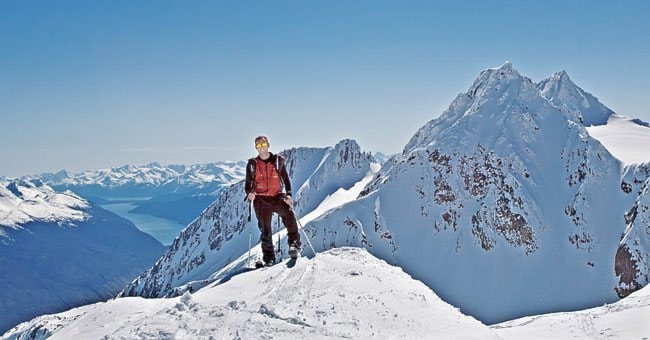Over the last three years, Claude Vallier has criss-crossed the White Pass slopes and carefully documented the details of his excursions.
In this famous mountain corridor linking Canada to Alaska, dozens of trails are accessible to skiers. But until now, no one had identified or mapped them.
With his camera strapped to his back and a notebook in his backpack, this outdoor enthusiast climbed many of the mountains surrounding that valley.
“I have skied to a lot of unnamed peaks,” he says.
In December, Vallier published the White Pass Backcountry Skiing Guide, offering cross-country ski enthusiasts a directory of expeditions they can make to exotic destinations.
Imagine climbing peaks overlooking an age-old trail first travelled by the Chilkat First Nation and then by thousands of gold seekers a hundred years ago during the Klondike Gold Rush! Who can beat that?
Vallier was well qualified to carry out this project. He grew up in Grand-Bornand, a very popular ski resort in Haute-Savoie, eastern France. He spent his youth on the slopes and joined the police force as a search and rescue specialist, working at the famous Chamonix Mont Blanc resort, where almost 2,000 rescues take place every year.
“Thanks to this experience, I became well acquainted with all potentially dangerous situations,” he says. This high number of incidents illustrates how the quiet Alps of his youth are a thing of the past.
Today, human impact can be heard and seen everywhere. Cable-cars, ski chalets and air corridors have transformed the peaks into noisy highways for skiers.
For Vallier, skiing is more than just sliding down a powdery slope. “The solitude, the silence, the knowledge that you are almost certainly the first human being to set foot here put you into a different dimension. That’s what the Yukon offers,” he says.
He talks with disappointment about the few excursions where his instinct told him to go back, but his eyes sparkle as he describes his most incredible moments on the mountains. “Speeding down slopes that you climbed in the morning, as endless sunsets turn the snow into a golden carpet.” Can you imagine?
Vallier now hopes to map new excursions in the Haines Pass, another historic trail with incredible landscapes a little further north. He is so enthusiastic that he will be out noting down his observations even in the summer.
“Claude can look at a mountain in the summer and already know which corridor he will ski come winter,” says his partner Mirjam, proudly illustrating her husband’s expertise. His fans are no doubt hoping that it will not be another three years before he shares his secrets again.
For more information on the White Pass Backcountry Skiing Guide: http://yukonbackcountryskiing.com
This article is excerpted from the third edition of a tourism brochure created by Association franco-yukonnaise. You can get a copy of the brochure (in French) at the Centre de la francophonie in Whitehorse or at the tourism information centre in your community.
